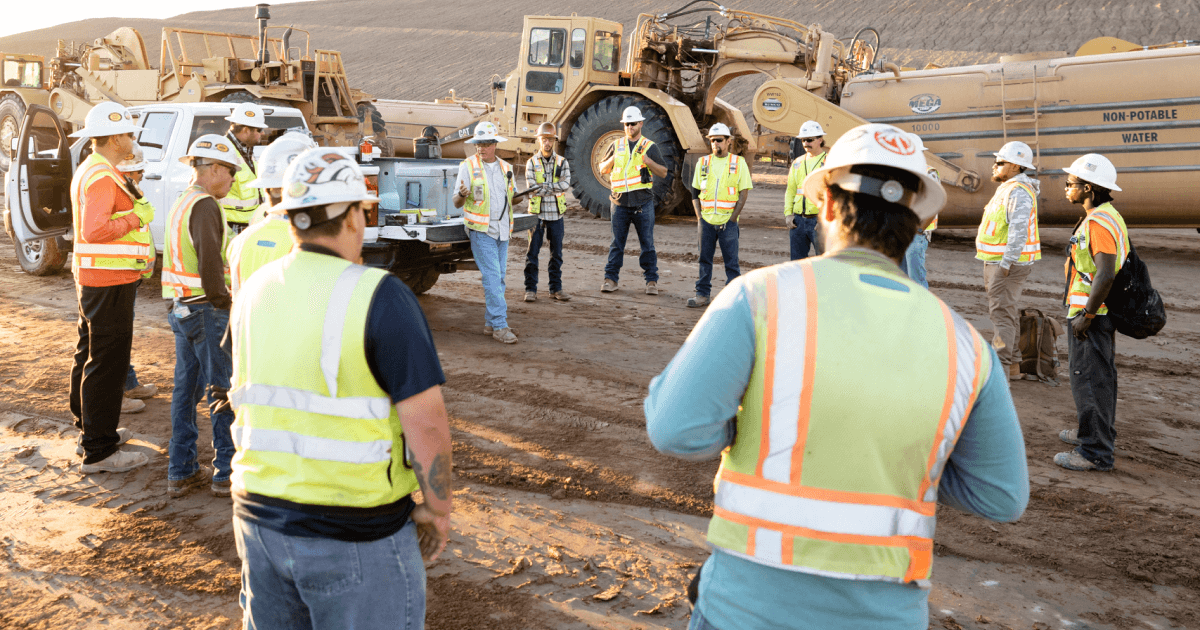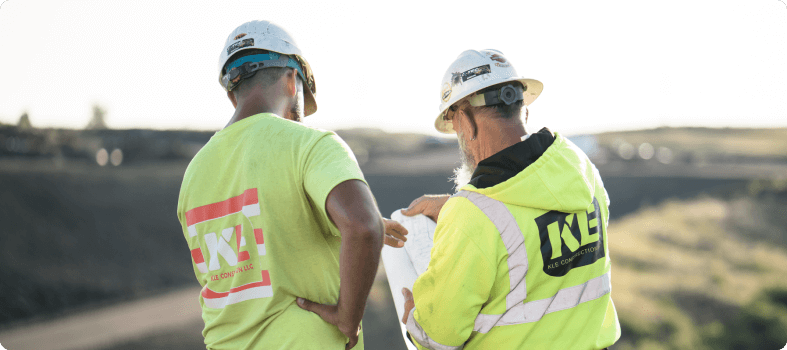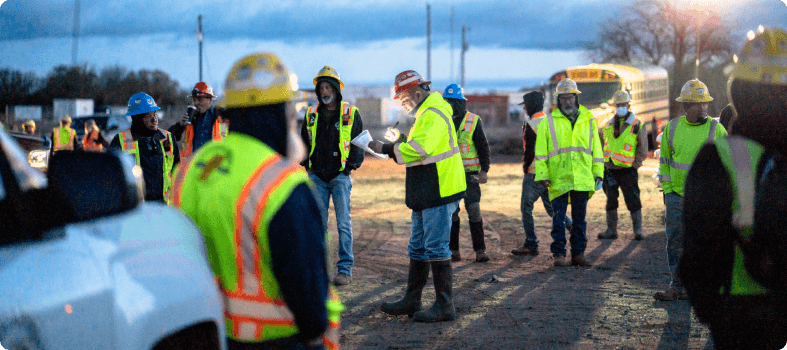Train Like a Small Team When You’re Spread Out
Written by Marilee Brewer
December 2, 2022

Has your company’s growth forced you to change your thoughts about training? Maybe you’re expanding to add more crews, and maybe some of those crews are in new cities or states.
It’s not merely a problem of being unable to fit everyone into one room. When jobsites are hundreds of miles apart, it’s tough to touch base and send a message, let alone gather everyone for training.
If you have multiple crews working on jobsites spread out over long distances, figuring out how to promote healthy company culture, keeping everyone on the same page, and training effectively can seem daunting. Fortunately, you’re not at the mercy of the miles. You can still give your big team the close-knit feeling of a small shop.
Here are three things you can focus on to help make your training efforts worthwhile.
1. Make it memorable

As humans, we use memory to navigate life. Our brains store the important stuff so we can retrieve it when needed, but they scrap the rest. 1
The same is true of workplace training. Crew members retain what’s engaging and helpful, then forget the rest. If your training is unengaging, simply doing more of it won’t work. And that’s even truer when you’re training spread-out crews remotely. Fortunately, there are a few simple ways to help your team retain their training.
Use a microlearning program
Microlearning gives users short, engaging content that captures crew members’ attention. Examples of microlearning include things like videos, images, text, games, and quizzes. Whatever form it takes, it’s always brief—usually under five minutes.
Microlearning can cover everything you need to train for, from machine walkarounds to new hire safety. And because it’s so short and punchy, it helps crew members retain the material better.
The thing is, not very many construction training programs use a microlearning approach, even though it’s so helpful. When you’re looking for training software, be sure to look for a program that delivers these short, relevant lessons.
Tie in physical movement
Do your crews do morning stretches during their toolbox talks or JSAs? Moving before or while talking reinforces the message.
Recent studies have confirmed what many teachers and coaches intuitively know: memory and movement go hand in hand. Whether it’s long-term memory or short-term retention, adding movement increases people’s capacity to recall what they learned. 2
It’s even better if the movement connects with the material. Having your team physically practice what they’ve just learned is much more effective than sitting in a classroom watching videos or slides.
Maybe they’re learning to assemble a hard hat or use three points of contact to climb a ladder. Whatever the case, if they can see it and practice it, their likelihood of remembering the lesson skyrockets.
Make it a competition
People are competitive by nature—some more so than others. And that’s a good thing! When people experience a healthy sense of competition, they’re more likely to try harder. Competing against themselves, others or for a prize can motivate your crew members to put their best foot forward and dig into their training.
Your best bet for a more effective training program should include games or allow users to challenge themselves or each other. You can also up the ante by offering prizes to whoever does best on their assessments or trains most consistently.
2. Stay organized

If your training plan is going to work across distances, the leadership team has to stay organized. Just like with project planning, you’ll need to be several steps ahead of what the team is currently learning and keep close track of everyone’s progress and participation.
Here’s how you can keep the front office and the field organized.
Commit to a training program
While it might be tempting to dip a toe into training “just to see” if it works for you, you won’t get the full effect unless you approach it wholeheartedly. In the words of business personality Ed Mylett, you’ve got to go the route of a champion: all-in.
Mylett explains, “Champions get great at something because they dive into it and get adapted quickly. Average people are the people who constantly take their time . . . They think, I can’t do this until I’m ready. If I’m not ready, I’ll mess it up. The truth is, that’s not how life works. If you go slow, you’re extending the time you’re in pain . . . while the champions have already acclimated and started riding the waves.” 3
Get a training program that offers individual logins and tracking
On a spread-out team, everyone needs to be able to access their training content when they need it. So you’re looking for a training program to give each crew member and leader their own user log-in.
It helps to be able to assign individual and group learning plans, too. That way, you can have local crews complete lessons together—or if you’ve got an urgent message to send out, everybody can watch it immediately without waiting to get in the same place.
You also want to invest in software that includes easy-to-use tracking, so you can see who’s making progress on their lessons and who might need help.
Keep the conversation going
Gold Rush’s Dave Turin has been through a lot with his crews, and he’s realized through thick and thin that leaders and crew members are responsible for fostering communication by staying vulnerable and speaking honestly.
Honest communication between HQ and field offices assures your leaders that you value their input. Likewise, real conversations between field leaders and crew members help each one value what the other does. When people know they are valued, they engage even more. And when it comes to healthy culture and productivity, engagement is everything.4
Another way to improve communication (and training) is: Tailor it so people can understand it. Former Navy Seal Jocko Willink says this helps create unity between the field and the office.
That said, you can’t create personalized training for every crew member. You need a well-balanced program that embodies the principles of good communication by creating open, honest dialogue among crews and leaders.
You want to feel like the whole team is in the room together. You’re looking for courses from real-world experts who don’t gussy things up for anybody. They keep it real—but do it in a way that works for crew members in the field and leaders back at HQ.
That’s the number one takeaway here: training software from good teachers can start conversations—and authentic communication—among your employees.
#3: Set your company standard

While all healthy companies share certain characteristics, your company is as unique as those who work for you. That’s why it’s so important to set the standard with your leaders right out of the gate: what does training look like at your company? How can you make sure your training lines up with your values and the way you do business?
Having a gold standard of training at your company also helps create a consistent experience for your crew members. How you do business, the quality of tools you use, the benefits you provide, and the training you offer all reinforce the company’s identity and values.
Train your leaders first
The place to start setting the standard is always with your core leadership team. As Dave Turin says, leaders communicate culture by casting a vision of where the company’s going. Translation: culture comes from the top.
And according to lean construction expert Jason Schroeder, “It doesn’t matter what your strategy is. What matters is your culture—your group's common beliefs and actions. Culture will always trump strategy.” Culture is how you improve your company.
Forbes writer Jason Mayo agrees. He’s been studying successful and unsuccessful companies for years and believes culture is the make-or-break factor. He explains, “Culture always has to start from the top and trickle down. In my opinion, there are no exceptions. As much as we'd like to think company culture happens organically, this usually isn't the case. There is no magic button.”5
That’s why Schroeder emphasizes the need to manage, mentor, and coach your direct reports—in other words, develop your leadership team. They’re the ones who are going to help you set and maintain your company culture and the training that upholds it, so they need to experience that training first.
Think beyond the classroom
You hire people because you need them to work. Get your new people productive quickly with a modern training system that’s engaging and easy to apply in the real world. It will teach them the trade and safety protocol tasks quickly so they can do the job you hired them to do.
Another part of thinking beyond the classroom is making sure new hires understand your company values. You may think they signed on for the paycheck, but people need much more than money. They need meaning.6 You must communicate the importance of what your company does and hardwire it into your training program from day one. Then, crew members can carry the company values onto the jobsite and do the kind of work you can all be proud of.
Keep it consistent
When you’re training multiple crews in multiple cities, states, or even different time zones, you run into some unique problems. For instance, you may have a classroom trainer teaching Crew A one thing, but Crew C is learning something completely different from another trainer. That’s no good. You need everybody on the same page.
A plug-and-play training app can help you create a seamless learning experience no matter where your crews are located. You can assign your crew members the same videos and send the same important messages to everybody. Then, you don’t have to worry about someone missing something or having variable standards across the company. You can rest assured that you’ve created a consistent, gold-star training experience for every employee.
The training software we recommend
If you’re getting too big for the training room, look at it as an opportunity—not a limitation. Your business is growing, and that’s something to celebrate!
To help you make the most of that opportunity, we created BuildWitt Training. Our content library includes 800+ modern, engaging microlearning videos on everything from leadership to safety to checking grade math. We have more videos on the way, and you can even upload your own custom training content at no extra charge.
BuildWitt Training gives your employees an easy-to-use app that they can access anywhere, any time. And it gives you the tracking and communication features you need to help your team succeed. You’ll have everything you need to create the close-knit culture of a small team even as your business grows.
More about
Sand Cone Test for In-Place Density Testing Soil by Sieve - Minus #40 5 Heavy Equipment Maintenance TipsMeet the Expert
Marilee Brewer
Marilee Brewer's philosophy on heavy civil construction is that everything—even the Bingham Canyon Mine and the Willis Tower—starts with ideas put into words. An avid writer and researcher, Marilee brings inspiration, storytelling, and human candor to Dirt World information. Her writing focuses on providing content that enhances user experience, improves engagement, and ultimately increases revenue. A trained Linguist and social media storyteller, ask her for story and social media writing tips.














